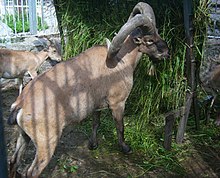East Caucasian Ibex
| East Caucasian Ibex | ||||||||||||
|---|---|---|---|---|---|---|---|---|---|---|---|---|

East Caucasian Ibex in the Kabardino-Balkarian High Mountain Nature Reserve |
||||||||||||
| Systematics | ||||||||||||
|
||||||||||||
| Scientific name | ||||||||||||
| Capra cylindricornis | ||||||||||||
| ( Blyth , 1841) |
The East Caucasian Ibex ( Capra cylindricornis ) is also called Daghestan-Tur and lives in the eastern parts of the Caucasus. Like the other ibex, it belongs to the goat genus . Traditionally, the East Caucasian Ibex and the West Caucasian Ibex are considered separate species. Genetic studies seem to confirm this separation. The West Caucasian Ibex seems to be more closely related to the Bezoar goat ( Capra aegagrus ) than to the East Caucasian Ibex. The outward similarities within the Caucasian Ibex could therefore be due to hybridizations between the two species. This thesis is also supported by the fact that the mitochondrial genome of individual West Caucasian ibexes corresponds to that of East Caucasian ibexes.
Appearance
The East Caucasian Ibex looks very similar to the West Caucasian Ibex ( Capra caucasica ). He has the same massive, stocky stature and is about the same size. It differs from this mainly in the even shorter beard and the larger horns, which do not describe a round arch but are twisted in a spiral and are somewhat reminiscent of those of the Iberian ibex . The horns of the bucks are up to one meter long and, above all, because of their large diameter, they are an impressive headdress. Those of the females are much smaller and a maximum of 30 cm long. The head trunk length of the bucks is 130 to 150 cm, the shoulder height 79 to 98 cm and the weight 55 to 100 kg in the East Caucasian Ibex. Females only reach a shoulder height of 65 to 70 cm and a total weight of 45 to 55 kg. The winter fur is usually dark cinnamon brown to hazelnut brown, while the summer dress is significantly lighter and more reddish. The underside is always slightly lighter.
distribution
The distribution area is the Eastern Caucasus , here the states Russia, Georgia and Azerbaijan . Like the populations of the West Caucasian Ibex, those of the East Caucasian Ibex have also declined sharply since the 19th century, primarily due to uncontrolled hunting. In some areas, however, the populations have recently been able to recover somewhat thanks to suitable protective measures. According to the IUCN, the total population of the East Caucasian ibex could only be a little over 10,000 adult animals, and the species is classified as “ near threatened ” .
Way of life
Caucasian ibex live on cliffs and steep slopes of the Caucasus at altitudes between 800 and 4200 meters. There you can find them on meadows, scree fields as well as in the forest. Like all ibex, they climb excellently. In summer, the animals usually stay at higher altitudes than in winter. In autumn they descend 1500 to 2000 meters to lower elevations. In contrast to winter, when these ibex like to hang out on sunny, open slopes, they like to seek out shady spots during summer. Their diet consists of grasses, leaves and herbs, with deciduous food playing a greater role in winter than in summer when they mainly feed on grasses. The animals form large herds at times, so groups of 500 animals have already been observed. The more stable small groups that make up these large herds, however, usually only consist of about a dozen animals. In the rutting season, which is between November and January, the goats, which otherwise live away from the herds, join the herds of the females. Then they fight fierce battles among themselves for the females ready to conceive. After a gestation period of 150 to 160 days, these give birth to a single, rarely two, fawns.
literature
- Ronald M. Nowak: Walker's Mammals of the World . Johns Hopkins University Press, 1999, ISBN 0-8018-5789-9 .
- D. Macdonald: The Great Encyclopedia of Mammals. Könemann Verlag, Königswinter 2004, ISBN 3-8331-1006-6 .
Web links
- Capra cylindricornis onthe IUCN Red List of Threatened Species . Retrieved July 22, 2009.
- Ibex in the Caucasus. ( Memento from June 11, 2012 in the Internet Archive ) In: GEO: Video and Info
